The global classroom
Individualised and available everywhere at any time: digital education opens up all kinds of new possibilities and brings us a step closer to realising an old vision.

People all over the world have long since come to realise that digitisation offers new opportunities. This is confirmed time and time again by the way they shop and the way they communicate in their daily lives. And so it comes as no surprise that the Internet and big data are also changing our systems of education. But this involves a great deal more than simply equipping schools and universities with tablet computers and interactive whiteboards. Digitisation is bringing about the most radical transformation in education since book printing was invented or compulsory schooling was introduced. In everyday education, digitisation means dismantling the obstacles that prevent people from accessing education, tailoring educational content and the pace of teaching to individual needs, and generally making it easier for people to find their way around the wide range of educational offerings.
Wilhelm von Humboldt, a leading nineteenth-century educational reformer, appealed for “educational for everyone” as the foundation for a self-determined life, and established the general school system. His vision, which long remained unrealised, was that anyone with talent should be able to advance in society, regardless of their background. Thanks to digital education, society is coming gradually closer to achieving this vision – though so far to differing extents at the local level.
In Uruguay, for example, the government has introduced interactive software for mathematics lessons at all state schools. The software first assesses the individual ability level of each pupil, and then provides them with appropriate maths problems to solve. The exercises become tougher as the pupil progresses, with mistakes being explained by the software if problems arise. This allows pupils to learn on a highly individual basis; no longer are they forced to follow the textbook, with lessons tailored instead to the pupil. Named “Bettermarks”, the software’s goal is to avoid challenging pupils too much or too little and to reduce boredom and stress. Using the software leaves teachers with more time to focus on the essentials: they can teach pupils rather than content and provide help where this is needed – not least when it comes to questions of social interaction or personal problems.
Developed in Berlin, the “Bettermarks” maths software is currently being used in around 400 schools in Germany. Other schools could join them, but clearly it takes a while for the realisation to sink in that digital learning does not need to pose an additional burden but can actually be part of the solution to many challenges in education.
One example: around 80 percent of pupils at the David Boody School in New York‘s Brooklyn district are given a free lunch each day; many of them are from socially disadvantaged families, often of migrant origin, and require a lot of educational support. For some time now, they have been enjoying not only a free lunch but also personalised lessons. The “New Classrooms” concept relies on digitised learning modules rather than a teacher-centred direct instruction approach, and tailors content to the knowledge level of each individual pupil. In a room covering an entire storey of the school, roughly 90 pupils move from one station to another, learning as they go: some watch videos, others use educational software, while yet others work in groups or talk to the teacher.
German success stories such as Sofatutor, a Berlin-based start-up company that provides more than 13,000 online videos to give pupils extra tuition in all school subjects, show what is possible. Schools like the Oskar-von-Miller-Berufsschule, a vocational school in Kassel, use a wide range of digital support tools and employ similar ideas as those in the “New Classrooms” model. And they are successful. In the “Glassrooms” project for example, agricultural machines can be repaired in a virtual setting. In vocational schools, experimentation takes place primarily in virtual educational settings; this allows apprentices to learn the necessary work steps without the need for expensive machines. There are similar examples to be found in the printing industry, where apprentices nowadays can use tablet computers to take a virtual look inside running printing machines – something that would never be possible without digitisation.
Naturally there are also risks involved in digital education: pupils and teachers generate a considerable data trail online, data that could potentially be misused. A legal framework for greater data security therefore needs to be established, and a campaign launched at the same time to improve the digital skills of teachers and pupils. What is needed above all, however, is the courage to innovate. ▪
Ralph Müller-Eiselt heads the “Participation in a Digitised World” project at the Bertelsmann Stiftung and co-authored the book “Die digitale Bildungsrevolution” (i.e. The Digital Education Revolution). Julia Behrens is responsible for the “Digital Education Monitor” project at the Bertelsmann Stiftung.
